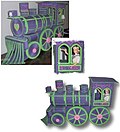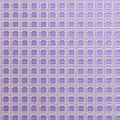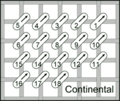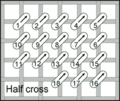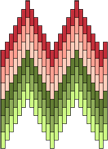AY Honors/Plastic Canvas/Answer Key
1. What is plastic canvas?
- Plastic canvas is a lightweight plastic material with regularly spaced holes in imitation of embroidery canvas. It is also commonly known as vinyl weave.
- Plastic canvas is as the base/foundation for needlepoint or other canvas work embroidery, usually in acrylic or wool knitting yarn. Because the plastic is rigid, it can be used in creating 3-dimensional projects like tissue box covers, small jewelry boxes, handbags, and other decorative items.
- Plastic canvas comes in many colors and various size holes for different thicknesses of yarn. As with textile canvas, these are described in count – 10-count plastic canvas has 10 holes per linear inch. Typical sizes are 7-, 10-, and 14 count. It also comes in pre-made shapes such as circles, triangles, as well as novelty shapes (e.g. dinosaurs, birds, etc).
- Plastic canvas is also used to teach needlepoint and cross stitch to children, because it is rigid and does not need the use of a hoop or frame.
2. Name four(4) types of plastic canvas and give a brief description of each.
On the project pattern you will find that the plastic canvas grid is either counted out by using the terms lines or threads or by holes or squares. You can find the following four sizes:
- 5 holes to the inch
- 7 holes to the inch
- 10 holes to the inch
- 14 holes to the inch
Plastic canvas sheets are clear or colored, stiff or soft, which becomes the following four types:
- clear & stiff
- clear & soft
- colored & stiff
- colored & soft
3. Which type of yarn is best for use on plastic canvas?
The best type of yarn to use is regular worsted weight yarn. It is inexpensive, comes in many colors, and is widely available.
4. Describe the following types of yarn and say on which type of canvas they work best:
a. Worsted Weight Yarn
b. Sport Weight Yarn
c. Tapestry Yarn
d. Persian Wool
e. Pearl Cotton
f. Embroidery Floss
5. What type of needle is used on plastic canvas? Which size needle is used on each type of plastic canvas?
6. Which instruments are used for cutting plastic canvas? How do you cut plastic canvas?
first you need a good cutting board...anyone know where to find one???
7. Name at least ten (10) stitches and make a one-inch sample of each.
Tent Stitch
Tent stitch is a small, diagonal embroidery stitch that crosses over the intersection of one horizontal and one vertical thread of needlepoint canvas forming a slanted stitch at a 45 degree angle. It is also known as Petit point and Needlepoint stitch and is one of the most basic and versatile stitches used in Needlepoint and other Canvas work embroidery.
Tent stitch variants
There are three types of tent stitch, all producing the same appearance on the front of the canvas but each worked in a slightly different way and having particular characteristics, uses, benefits and drawbacks. These variants of tent stitch are known as basketweave, continental and half cross tent stitches:
- Basketweave tent stitch
The basketweave form of tent stitch is worked in diagonal rows up and down the canvas. The yarn on the back of the canvas has a typical basketweave appearance, with alternating horizontal and vertical stitches. Basketweave is the best stitch to use for covering large areas of canvas as it does not distort the canvas as the other two forms of tent stitch do.
- Continental tent stitch
Continental stitch is worked from right to left across the canvas. It's primary use is for working a single row of stitching but may be worked in multiple rows if necessary. It can also be used for stitching vertical lines. It is normally used for working a single line or for filling very small areas because of the tendency of the stitch tension to pull and distort the canvas ground fabric out of shape. This method uses more yarn than half cross stitch tent stitch but is more hardwearing.
- Half cross tent stitch
Half cross stitch is worked from left to right across the canvas. As with Continental tent stitch it's primary use is for working a single row of stitching but may be worked in multiple rows if necessary. It can also be used for stitching vertical lines. It is normally used for working a single line or for filling very small areas because of the tendency of the stitch tension to pull and distort the canvas ground fabric out of shape. This method uses less yarn than other stitches but is not very durable as coverage on the back of the canvas is a little thin.
Bargello Technique
Bargello refers not just a stitching technique, but motifs created by the change of colors in the stitches. This section describes the vertical stitch and how it is combined with color and ‘stepping’ to create different motifs.
Examples
Image(s) created and licensed by Elizabeth Pyatt.
- Ribbons.png
Ribbon design.
Stitches are gradually stepped in different colors.
Vertical Stitches
Most agree that traditional Bargello pieces incorporate a series of all vertical stitches (vs. diagonal stitches). The basic unit is usually a vertical stitch of four threads, but other heights are possible.
Some Bargello pieces use only one height of stitch, but even the earliest pieces (such as chairs in the Bargello museum) combined different heights of stitches.
Stepping
Bargello patterns are formed when vertical stitches are stepped or offset vertically, usually by two threads (i.e. halfway down a unit of four threads). The patterns in the steps combined with color changes determines how the overall pattern will emerge.
Flame (Sharp) vs. Curved Motifs
If vertical stitches are stepped down quickly, the design forms sharp points or zig-zags. This type of Bargello motif is often known as "flame stitch." Flame stitch can be found on the Bargello Museum chairs.
If steps are gradual, then the design will appear to be curved. Traditional curved bargello motifs include medallions and ribbons.
